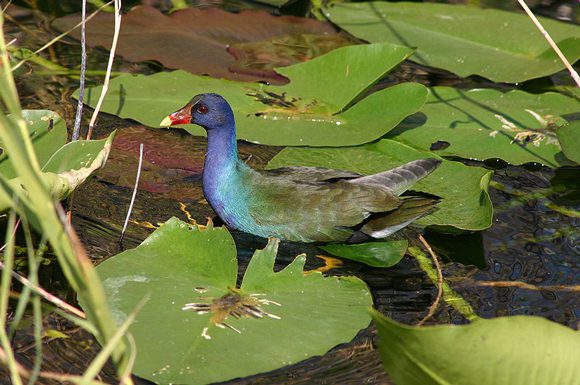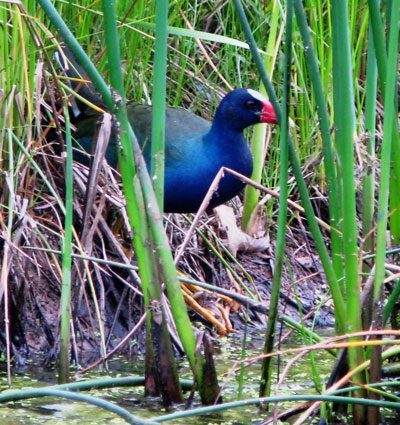Eye-catching purple gallinule rare in N.C.

Whether you’re an avid birder or just enjoy watching those in your backyard, you likely have heard of the Cornell Lab of Ornithology. Although affiliated with the university of the same name, it is a nonprofit organization dedicated to the study and conservation of birds. Its mission is “to interpret and conserve the earth’s biological diversity through research, education, and citizen science focused on birds.”
I am a fan of the group’s Facebook page and I particularly like their bird trivia feature. They post a picture of a bird, sometimes partially obstructed to make it more difficult, and encourage followers to guess what it is. Last week’s was just a glimpse of a really spectacular bird – one with shiny purple and green iridescent feathers, long, bright yellow feet and toes, and a white tail. I wasn’t familiar with it but was instantly intrigued.
Apparently many other people were aware of this unique bird, and despite the photo showing only the back side and legs, it was quickly identified as … a purple gallinule.

The American purple gallinule (Porphyrio martinica) is a member of the rail family and looks like a duck, but has a bill more like a chicken’s. They are colloquially known as “swamp hens.” They live in marshes, and their long toes are particularly apt for walking on lily pads and other floating vegetation. In addition to their striking plumage, they have a bright red bill with a yellow tip and a blue streak on their forehead – two distinctive attributes not visible in the trivia photograph.
They are more prevalent in the Florida Everglades and the tropics, but breed all along the southeastern United States and winter in South America. North Carolina is about as far north as the birds typically venture, although they are occasionally found outside of their normal ranges and habitat. The gallinule is a game species in North Carolina but is difficult to find, and sightings are rare. They occupy marshy areas with dense vegetation and, although brightly colored, are secretive birds. They are declining in number, but the reasons for this are not well understood. However, due to an expansive range and overall large population, the species is not listed as a threatened species, but is one of some concern.
To learn more about this species or how you can help with conservation of it and many other birds, you can check out the “All About Birds” site at the Cornell Lab of Ornithology.
Editor’s note: Last May an American gallinule showed up in a retention pond in the Gilead Ridge subdivision in Huntersville. First spotted by Lisa Gaffney, the sighting was a Mecklenburg County first and drew dozens of birders. Phil Fowler was one of many who photographed the bird, and he shared his photo with the UNC Charlotte Urban Institute. Click here to read Taylor Piephoff’s article from last May in the Charlotte Observer.